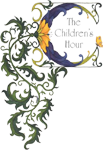|
Book Reviews
Click on book cover to return to top
|
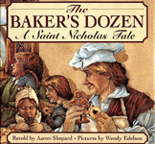 |
The
Baker's Dozen: A Saint Nicholas Tale,
written by Aaron Shepard, illus. by Wendy Edelson, (Antheneum Books
for Young Readers, 1995), 32p, Ages 5-8.
Full of generosity and honesty, this holiday tale tells how thirteen
became a "baker's dozen." An old woman questions
a baker's heart when he refuses to give her an extra Saint Nicholas
cookie after she purchases twelve. Poverty follows the baker until
he realizes how to count again. |
|
Beetle
Bedlam, written &
illus. by Vlasta van Kampen, (Charlesbridge Publishing, 1997), 32p,
Ages 5-9.
A tiny bark beetle is accused of killing the forest trees and endangering
the insect environment. On trial for his destructive eating habits,
the humble beetle declares his innocence before the assembled beetle
kingdom. Will the verdict be innocent or guilty? This is a clever
and interesting way to introduce children to the fascinating world
of beetles. |
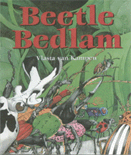 |
|
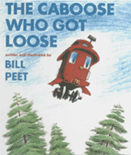 |
The
Caboose Who Got Loose,
written & illus. by Bill Peet, (Houghton Mifflin Children's
Books, 1971), 48p, Ages 5-8.
Katy is a caboose who is tired of being the last car in the freight
train. It's just too noisy, smoky and jerky to her way of thinking.
Katy longs for the simple, quiet life but has little hope of achieving
it, until one day an accident releases her from the train. Find out
how she spends the rest of her days with plenty of fresh air, peace,
solitude and a great view. |
|
Chanukah
in Chelm, written by David
A. Adler, illus. by Kevin O'Malley, (Lothrop, Lee & Shepard
Books, 1997),
32p, Ages 6-9.
For centuries, tales have been told about the kindhearted but foolish
people of Chelm who manage to turn the easiest tasks into monumental
quests. Mendel, a good-natured, hardworking caretaker of the synagogu,
needs a table to hold the menorah on the first night of Chanukah.
In the storage closet, the caretaker is unable to locate a table (he's
leaning on it), so he borrows one from the local workshop, "Tables
Are Us." On the way home, Mendel decides the table is too heavy
and concludes that since it has four legs, it could very well walk
by itself. |
 |
|
 |
Chin
Yu Min and the Ginger Cat,
written by Jennifer Armstrong, illus. by Mary GrandPré, (Crown
Publishers,
1993), 32p, Ages 4-8.
Chin Yu Min lives a life of wealth and idleness until one day her
lifestyle abruptly ends and she becomes "as poor as a mouse
in a monastery." Forced to earn a living, the greedy old woman
finds a mysterious cat who agrees to catch fish for her. Only upon
losing the ginger cat does Chin Yu Min develop humility and kindness. |
|
Clown,
written & illus. by Quentin Blake, (Henry Holt & Co., 1996),
32p, Ages 4-8.
In a wordless picture book, Quentin Blake presents an eloquent story
of a small rag doll that was thrown out in the trash. He is determined
to rescue and find a new family for all the other discarded toys.
His search has its ups and downs, but it eventually leads to a young
girl and her baby brother who are in need of a little love themselves. |
 |
|
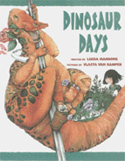 |
Dinosaur
Days, written by Linda
Manning, illus. by Vlasta Van Kampen, (Troll Associates, 1993),
32p, Ages 3-7.
Dinosaurs cavort through this concept book that was written to introduce
children to the days of the week. On each day, a different dinosaur
appears to create havoc in a little girl's life. One can enjoy
this creative book for the illustrations alone. |
|
The
Dog That Dug, written
by Jonathan Long, illus. by Korky Paul, (Kane/Miller, 1993), 28p,
Ages 4-8.
Told in rhyme, this hilarious story surrounds a forgetful pooch who
is determined to locate his missing bone. With perseverance, he digs
deeper and deeper in the backyard, turning up the most unusual things
in the process, but no bone. Digging down through the city's
plumbing, past a coal miner and a subway train, he finally locates
a bone. However, it is connected to other bones - dinosaur bones. |
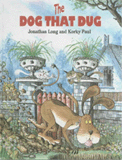 |
|
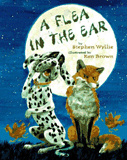 |
Flea
in the Ear, written by
Stephen Wyllie, illus. by Ken Brown, (Dutton Children's Books, 1996),
32p, Ages 4-7.
A big lovable hound dog, guardian of the chicken coop, has a major
flea problem. When a sneaky fox proposes a plan for the dog to rid
himself of the fleas, the chickens end up missing. Discover how one
industrious dog outfoxes the thief, makes a deal with the fleas and
gets his chickens back home safe. |
|
Into
the Sea, written by Brenda
A. Guiberson, illus. by Alix Berenzy, (Henry Holt & Co., 1996),
32p, Ages 6+
The delicate life cycle of the endangered sea turtle is portrayed
in this beautiful illustrated information book. A newly hatched turtle
must crawl across the sand to reach the ocean. There she begins life
with many dangers and perils until she finally returns to the shore
where she was born to lay her own eggs. |
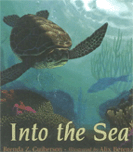 |
|
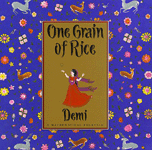 |
One
Grain of Rice: A Mathematical Folktale,
written and illus. by Demi, (Scholastic Press, 1997), 40p, Ages
6+
"Long ago in India, there lived a raja who believed that he
was wise and fair, as a raja should be." However, he was greedy,
keeping most of the farmers' rice for himself, and the people
were left with only enough to survive. A village girl, Rani, devises
a plan to return the rice to the people. In return for doing a good
deed, Rani asks the raja for one grain of rice, doubled every day
for thirty days. Surprisingly, one grain grows into more than one
billion grains of rice, and the raja learns a lesson about fairness. |
|
The
Velveteen Rabbit, written
by Margery Williams, illus. by Donna Green, (Smithmark Publishers,
1996), 48p, Ages 4-8.
After many years of being loved by a small boy, the velveteen rabbit
is old and dirty and most of his fur has worn off. In the nursery,
the velveteen rabbit discovers that if a toy is really loved, then
it becomes real. When thrown out, he almost gives up hope of finding
the magic of being "real." This story is a must for everyone
who believes in the power of love. |
 |
|
 |
Verdi,
written & illus. by Janell Cannon, (Harcourt Brace & Co.,
1997), 48p, Ages 4-10.
His mother tells Verdi that someday he will be big and green. However,
he enjoys being yellow and decides never to grow up and become lazy,
boring and rude like the big pythons. One day while recovering from
a flying accident, Verdi realizes that though he is now permanently
green, he is still the same old fun-loving, high-flying Verdi. |
|
Wilbur's
Space Machine, written
& illus. by Lorna Balian, (Holiday Books, 1990), 32p, Ages 4-8.
Wilbur and Violet enjoy their simple life in the country, but one
day they realize that gradually people have moved into their peaceful
valley and it is no longer a clean and quiet place to live. Surrounded
by smog, trash, garbage, and pollution, Wilbur decides to build a
space machine. In fact, Wilbur's machine created so much space
that they could not find enough containers to hold it all. Discover
how Wilbur and Violet unexpectedly find a peaceful place in which
to live. |
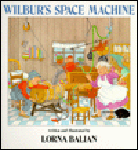 |
|
